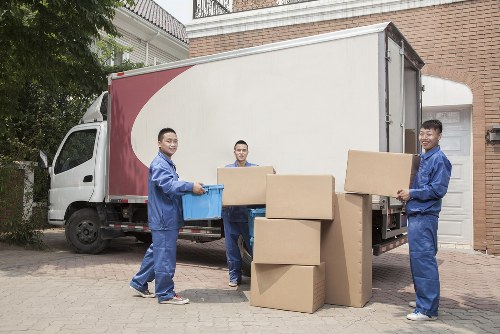Council Large Item Collection East London

When it comes to disposing of large items in East London, the Council Large Item Collection service provides a convenient and environmentally friendly solution. Whether you're renovating your home, clearing out clutter, or moving to a new place, understanding how this service works can save you time and effort.
East London residents have access to a comprehensive collection service that handles everything from old furniture to bulky household appliances. This service ensures that large items are removed responsibly, reducing the environmental impact and promoting recycling and proper disposal practices.
Scheduling a collection is straightforward. By contacting your local council or using their online portal, you can arrange for pickup at a time that suits you. It's essential to book in advance, especially during peak seasons, to ensure your items are collected promptly.

How to Schedule a Large Item Collection
Scheduling a large item collection in East London involves a few simple steps. First, identify the items you wish to dispose of and ensure they meet the council's guidelines. Commonly accepted items include old furniture, mattresses, large appliances, and garden equipment.
Next, visit your local council's website or call their customer service hotline to book a collection slot. You'll need to provide details such as the type and size of the items, your address, and preferred collection date.
It's also helpful to prepare the items for collection by placing them in an accessible location outside your home on the scheduled day. This facilitates a smooth pickup process and ensures your items are collected without delays.

Items Accepted by East London Councils
Understanding which items the council will collect is crucial for effective disposal. Typically, East London councils accept the following large items:
- Old sofas and chairs
- Washing machines and dryers
- Fridges and freezers
- Mattresses and box springs
- Bed frames and headboards
- Garden furniture and equipment
However, some items may require special handling or incur additional fees. For instance, electronic waste or items containing hazardous materials might need to be disposed of through specific recycling programs.
It's always best to check with your local council to confirm whether your items are eligible for collection and to understand any associated costs.

Collection Schedule and Restrictions
Each East London council has its own schedule and set of restrictions for large item collections. Typically, collections are offered several times a week, with specific days allocated for different types of items.
There are often limits to the number of items you can request for collection at one time. Additionally, certain items may be restricted due to safety or environmental concerns. For example, paints, chemicals, and asbestos-containing materials require specialized disposal methods.
To avoid any inconvenience, familiarize yourself with the collection schedule and adhere to the council's guidelines. This ensures a smooth and efficient collection process, minimizing any disruptions to your daily routine.

Costs Associated with Large Item Collection
While many councils offer free large item collections, some services may come with a fee, especially for non-residential properties or during busy periods. The cost structure varies depending on the council's policies and the size or type of the item being collected.
For residents, it's advisable to check the latest fee schedule on the council's website. Some councils offer discounts for low-income households or free collections for specific items deemed essential for recycling.
Additionally, bulk collections or special pickups may incur additional charges. Planning your disposal needs in advance can help manage these costs effectively.
Environmental Impact of Proper Disposal
Proper disposal of large items plays a significant role in environmental conservation. By utilizing the Council Large Item Collection, East London residents contribute to reducing landfill waste and promoting recycling initiatives.
The council ensures that collected items are processed correctly. Many materials, such as metals and plastics, are recycled, while hazardous substances are handled by specialized facilities to prevent environmental contamination.
Engaging in responsible disposal practices not only helps the environment but also supports community well-being. It fosters a cleaner, safer, and more sustainable living environment for everyone.
Areas Served by East London Council Large Item Collection
East London encompasses a diverse range of neighborhoods, each benefiting from the council's Large Item Collection services. Below are some of the key areas served:
- Stratford: Known for its vibrant community and proximity to major transport links.
- Greenwich: Offers rich historical sites and access to extensive recycling facilities.
- Bow: A residential area with a strong emphasis on community services.
- Ilford: Features a mix of urban living and green spaces, ideal for large item pickups.
- Walthamstow: Hosts numerous local markets and is well-supported by the council services.
- Hackney: A bustling area with diverse populations needing efficient disposal services.
- Canary Wharf: A business hub that also accommodates residential large item collections.
- Woodford: Known for its parks and family-friendly environment.
- Chingford: Offers a suburban feel with accessible collection points.
- Plaistow: Centrally located with convenient access to council collection services.
- Leyton: Features a blend of historical and modern residences.
- Dagenham: Industrial heritage with robust council support for waste management.
- Pantiles: A picturesque area benefiting from regular large item pickups.
- East Ham: A densely populated area with extensive council services.
- Forest Gate: Combines residential living with efficient disposal services.
Tips for Efficient Large Item Collection
Maximizing the efficiency of your large item collection can lead to a smoother experience. Here are some helpful tips:
- Plan Ahead: Schedule your collection well in advance to ensure availability.
- Sort Your Items: Separate recyclable materials from other waste to streamline the process.
- Prepare Your Items: Break down furniture and secure loose parts to facilitate easy pickup.
- Follow Guidelines: Adhere to the council's disposal regulations to avoid delays or additional fees.
- Communicate Clearly: Provide accurate information about the items and your location to the collection team.
Implementing these strategies can help you manage large item disposal effectively, saving time and reducing stress.
Additionally, consider donating items that are still in good condition to local charities or community centers. This not only helps others but also reduces the volume of waste heading to landfills.
Remember, responsible disposal is a collective effort that benefits everyone in the community.
Frequently Asked Questions
1. What qualifies as a large item for council collection?
A large item typically includes bulky household goods such as sofas, refrigerators, washing machines, and mattresses. The exact definition may vary by council, so it's best to check your local guidelines.
2. Is there a limit to the number of items I can schedule for collection?
Many councils allow a certain number of large items per collection. Exceeding this limit may incur additional fees or require multiple bookings.
3. Are there any items that the council will not collect?
Yes, items like hazardous waste, asbestos, and certain electronic components are usually excluded from standard large item collections. These require specialized disposal methods.
4. Can I schedule a collection for multiple properties?
Yes, but each property will typically need a separate booking. It's advisable to contact the council directly to arrange multiple collections.
5. What should I do if my scheduled collection is missed?
If your large item collection is missed, contact your local council immediately to reschedule. Providing detailed information about your request can help expedite the process.
